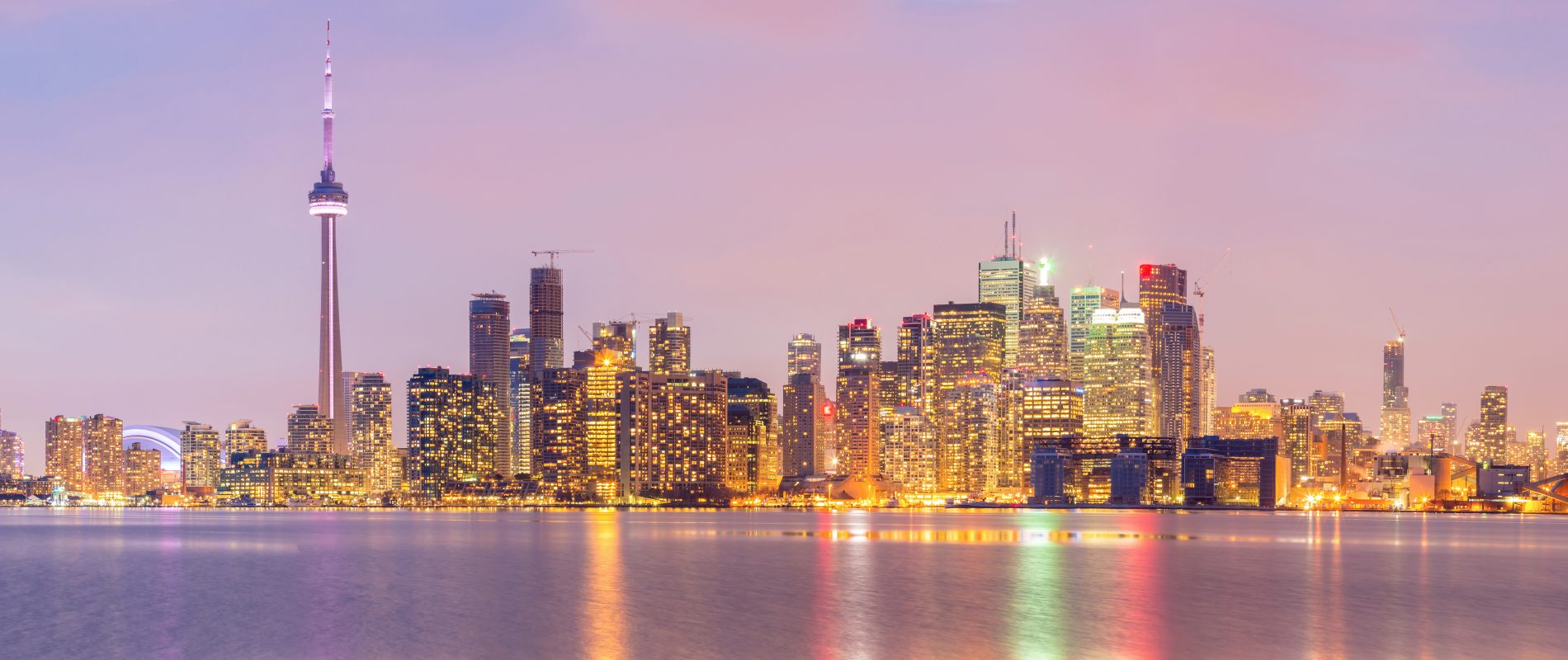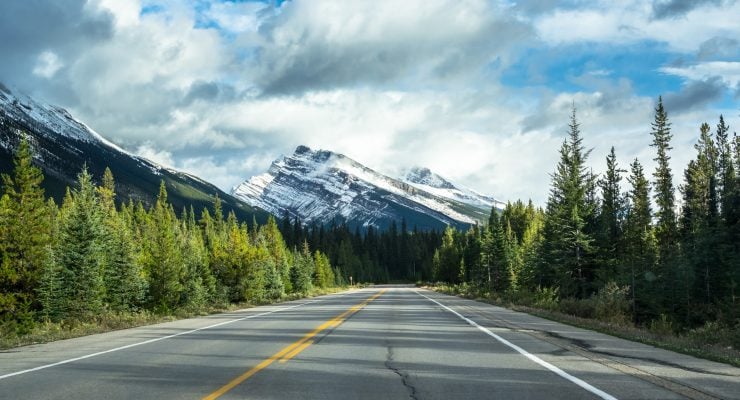Introduction to Toronto
It’s no wonder that Canada’s most populous city is a top choice for tourists, students and Working Holiday permit holders—the country’s business and financial capital is a vibrant destination with plenty of opportunities.
Looking to experience Toronto? Read this practical guide for an easy introduction to the city!
Click the buttons to navigate to:
What does Toronto look like?
If you’re flying into Toronto Pearson Airport, you will be met by the huge Greater Toronto Area (GTA), which includes the City of Toronto and the regional municipalities of Durham, Halton, Peel and York.
The City of Toronto covers 630 km². It became a “megacity” following the amalgamation of Etobicoke, Scarborough, York, North York and East York in 1998.
Toronto extends northward from the shores of Lake Ontario along Yonge Street, often dubbed the “longest street in the world.” “East” and “West” are divided by Yonge Street in Toronto, e.g. “Dundas West” is west of Yonge Street.
On postcards, Toronto looks like an urban jungle with towering skyscrapers, including the famous CN Tower. In fact, only the financial district offers this skyline. From the top of the CN Tower, you’ll notice most buildings are, at most, three-stories tall. It’s basically the best of both worlds—a typical modern North American cityscape combined with charming, historic neighbourhoods and a very reasonable population density of 4,427 people/km².
Much like many cities in the new world, Toronto follows a grid-like pattern with businesses lining East-West streets and residential areas on North-South streets (yes, there are exceptions!).
Pro tip: locals use intersections to give directions, i.e. College and Bathurst or Eglinton and Yonge (skip the “street” or “avenue” part).
Just how multicultural is Toronto?
Canada is a multicultural country but Toronto takes it to a whole new level—more than 50% of residents were born outside of Canada!
Toronto is often referred to as “the most diverse city in the world” and most newcomers love the international atmosphere. In today’s complicated world, it’s refreshing to see how open-minded and respectful people can be.
If you have an accent when speaking English, don’t worry—most people in Toronto do, too. This is a city where people from all walks of life can fit in easily and reach their personal goals through hard work, flexibility and perseverance.
Living in Toronto is also a chance to discover cultures from all over the world. If you were considering applying for a Working Holiday Visa to South Korea, Hong Kong, Chile or Portugal, you’ll feel like you’re halfway there in many neighbourhoods!
What are the vibes like?
Many Canadians see Toronto as a big city with big-city issues but frankly, by world standards, it’s a very safe place with a moderate crime rate. To put things into perspective, Toronto had 85 homicides in 2024—still too many, but a far cry from the hundreds of homicides that happened in other big cities that year.
The biggest issues are drug use and petty crimes.
Getting there and getting around
Pearson International Airport
All international flights arrive into Canada’s busiest airport, Pearson International Airport (YYZ), located in Mississauga. A few flights from the US and Canada land at Toronto City Airport, minutes from downtown Toronto.
Taxi and rideshare services are available at Pearson Airport but the cheapest option will likely be the Union Pearson Express train that takes passengers to Union Station in just 25 minutes for CA$12.35. Trains run every 15 minutes. You can buy your ticket online to save time, or you can pay by tapping on and off with a PRESTO, debit or credit card.
VIA Rail, GO Trains and buses
All trains leave from the central Union Station:
- GO Transit is the regional train with seven lines (excluding the UP Express), providing service to the GTA, Hamilton and the Greater Golden Horseshoe.
- VIA Rail is Canada’s long-distance railway system with service to other major cities and provinces (and even to the US with transfers).
GO buses generally leave from Union Station as well, and they connect with a number of subway stations. Check the GO trip-planning tool for details. Union Station is also where you can catch long-distance buses with companies such as Flixbus.
Public transportation in Toronto
The Toronto Transit Commission (TTC) operates a subway, streetcar and bus network to navigate the city.
There are only three subway lines, two of them very central—the U-shaped line 1 and east—west line 2. The third subway line connects Sheppard to Don Mills.
The TTC frequently close part of the tracks on line 1 and 2 for scheduled maintenance. Always check the service alerts before setting off, in case you need to take a replacement bus instead.
Note that streetcars and buses are often much slower than the subway because they stop more often and share traffic with other vehicles, except in a few parts of the city where there are dedicated public transport lanes.
Pay-as-you-go options include a monthly pass (CA$156/month or CA$143/month with a 12-month upfront payment) or a single ride, paid for by cash, card or PRESTO card, for CA$3.35.
The monthly passes are available for purchase from the last 12 days of the current month up to the 8th day of the next month.
Check fare and pass pricing for the most up-to-date information.
You may want to get a PRESTO Card and load it to pay your fare—it’s quicker and easier! It costs CA$4 for the physical card, or you can add a digital PRESTO card to your Apple or Google wallet for free. PRESTO cards are available for purchase at Shoppers Drug Mart, fare vending machines, and online (find locations here).
You can still pay in cash at subway fare vending machines, on the bus or on the streetcar, but you must have the exact change (or you won’t get any change back).
Note that you get a two-hour transfer window on Toronto’s public transport system!
As in most Canadian cities, Toronto’s public transport isn’t cheap, but at least there are no fare zones. The fare is the same regardless of the distance, so it’s worth taking if you live further out.
Cycling and walking
Toronto is a walkable city and, arguably, best explored on foot if you want to fully appreciate each neighbourhood’s atmosphere. During the cold winters, you can take the PATH, a 30-kilometre underground pedestrian walkway with restaurants, shops and services along the way!
Keep in mind that some streets are so long they feel endless on foot (looking at you, Yonge Street…), and two places that look close on the map can actually be kilometres apart.
You will quickly notice that not many locals use scooters or motorbikes, which makes sense considering that roads are slushy half of the year. Cycling is popular, though, and Toronto offers a Bikeshare program. Check the cycling network map to stay safe.
Driving in Toronto
Driver’s licence and traffic rules
You can use your foreign licence if you’re staying in Ontario for up to three months. For longer stays, you will need to go through the driver’s licence exchange process to switch your home licence for an Ontarian licence. Learn more.
Ontario has licence exchange agreements with certain provinces, states, and countries—check the full list and requirement details here.
Depending on your citizenship, you may have to show an International Driving Permit (IDP) or an official translation along with your foreign licence. This is especially the case if your home licence is not written in English or French. If you will need an IDP, you must get this document before coming to Canada, as Ontario doesn’t issue the IDP.
If you’re going to drive in Ontario, it’s probably a good idea to review local traffic rules and road safety. The Official Ministry of Transportation (MTO) Driver’s Handbook covers all the basics you (should) already know and a few Canada-specific situations. For instance, you must stop for school buses and streetcars.
Road network and parking spots
Downtown Toronto can be accessed by the Gardiner Expressway at the South End, the Don Valley Parkway (404) at the East End, Highway 427 at the West End, and Highway 401 at the North End. Highway 400 connects the city with Northern Ontario and beyond, and Highway 404 goes into the northern suburbs.
The 401 is one the world’s busiest highways—traffic is often slow and frustrating around Toronto, especially during construction season. Downtown Toronto is also often congested and no expressways cut through the city, except the aptly named Lake Shore Boulevard.
Parking is another issue in Toronto—there aren’t many available parking spots, parking lots are expensive, and there are lots of cars on the road. Quieter residential side streets can be an option. Otherwise, try a municipal parking lot.
Buying or renting a car
If you want to rent a car for your time in Toronto, start by reading Everything you need to know to rent a vehicle in Canada.
All the main companies like Avis, Hertz, Dollar, and Budget have offices in Toronto. Note that you will need a credit card (and not a debit card) to rent. Pvtistes offers discounts and perks if you rent a vehicle with Hertz, Dollar and Thrifty—check them out!
Car-sharing companies such as Turo can also be a good option if you don’t mind renting from a private car owner.
If you prefer to own a vehicle, read Buying a car in Canada for tips. Don’t forget to get auto insurance as well. Pvtistes.net has a great deal with YouSet to help you find the best price on your car insurance.
Tackling your to-do list to get started in Toronto
If you’re just getting started on an IEC permit in Canada, you will probably need to open a bank account, apply for your Social Insurance Number, get a mobile phone plan, etc. Toronto is a great city for tackling your to-do list, with many options and services designed for new residents. But first, read The arrivals process and your first steps in Canada to get your priorities in order for your first few days in Toronto.
How to find a place to stay in Toronto
For tips on finding the perfect place, deciphering rental ads and various legal matters, check out Finding Accommodation in Canada!
Where to stay: Overview of a few popular neighbourhoods in Toronto
Toronto is made up of a patchwork of neighbourhoods, each with a distinct atmosphere and many featuring a specific community—Chinatown, Little Italy, Koreatown, etc. All of the central neighbourhoods offer a mix of stores, businesses, activities, etc., so it’s really a matter of personal choice when deciding where to live.
Beyond the atmosphere and rent price, don’t forget an important search criteria—access to public transportation. Like in many North American cities, the public transportation network isn’t that extensive and it’s best to be a five-minute walk from a subway, bus or streetcar station (especially in winter!).
The best way to find your favourite spot is to explore the city on foot, visiting the neighbourhoods to see which ones you like and don’t like.
- The Financial District is the economic centre of Canada, with plenty of tall glass buildings home to companies’ headquarters and financial institutions as well as shopping malls, shops, bars and restaurants. This is where many high-end condo units favoured by single professionals rose up from the ground.
- South-west of the Financial District, the Entertainment District is where you celebrate the end of the workweek and a business deal. You’ll find plenty of bars and clubs but this is probably not the quietest place for a good night’s sleep…
- Along Dundas Street West, Little Italy and Little Portugal are two hip neighbourhoods with many shops, restaurants and bars. These neighbourhoods mostly come alive at night and on weekends.
- Queen Street West is a two-kilometre area close to the Financial District. The so-called “creative heart” of the city has it all—shops, eateries, flagship stores, art galleries and more. Unsurprisingly, it’s always lively.
- Centred on Bloor Street, The Annex is a vibrant neighbourhood home to a very eclectic community who lives in the leafy residential streets among small boutiques, restaurants and trendy shops. Close to downtown, this food and shopping mecca is a sought-after neighbourhood.
- Both west of the Financial District, Chinatown and Kensington Market are full of small businesses and cheap Asian and Latino eateries. Note that the main streets can be noisy, even late at night.
There’s no particular neighbourhood to avoid; just keep in mind that Toronto is very spread out. Public transit is very limited in residential suburbs, where you’ll need to consider a car. Traffic is also an issue, especially during morning and afternoon rush hours.
Living in the Greater Toronto Area (GTA)
If you find a job outside of Toronto, you may find it easier to live in the GTA to be closer to work, to enjoy lower prices and avoid a brutal commute.
Keep in mind that there may be fewer public transit options, which could be an issue with getting to work and visiting Toronto on days off. Some parts of the GTA are not walkable at all and a vehicle may be required even to go grocery shopping or to go out and have fun.
Types of accommodation
Hostels (for short-term stays)
Several centrally-located hostels welcome travellers for short stays. Since it’s generally not recommended to sign a lease before coming to Canada, booking a hostel for your first few nights in Toronto gives you time to explore various neighbourhoods and find a place that fits both your needs and your budget. Hostels are always a good place for meeting like-minded working holiday makers.
Shared housing
Sharing an apartment or a house with one or several roommates is a great option for working holiday makers—rent is cheaper, it’s a good way to meet people, and it’s generally easier to move out when you’re ready to move on.
Meet your future roommates and make sure you’re a good fit before committing to the lease. Ask about rules and clarify what your portion of the rent covers (utilities, Internet access, other shared household expenses, etc.). Communication is key in these types of living arrangements.
Rentals
As in most big cities around the world, Toronto is currently facing a housing crisis and rent has been pushed to new heights after the pandemic. Basically, rental units are scarce and expensive.
It’s important that you know your rights and obligations as a tenant. Keep in mind that you will probably be asked for references and the first and last month’s rent if you’re approved as a tenant.
Basement apartments are usually the cheaper option—yes, it may sound weird, but it’s perfectly legal to rent a basement in Canada. These apartments can be surprisingly cosy but the lack of natural light and the humidity are often the main downsides.
How to find a job in Toronto
For general tips and advice about navigating the job hunt, start by reading Finding a job and working in Canada.
Don’t forget to apply for your Social Insurance Number as soon as possible—it’s a mandatory step of the onboarding process, and your employer will ask for it within three days of your start date!
Employment resources
Several great resources for job seekers can get you off to a good start—some offer workshops, computer access, help with resumes, etc.
- Employment Ontario
- YES — Youth Employment Service (counselling, job placements and more)
- YMCA Employment Services
- The Career Foundation
Entry-level jobs and recruitment agencies
Most jobseekers start with an entry-level job to gain their first Canadian work experience and get local references—it usually makes future job searches much easier, especially if you’re looking to move up or find a more relevant role. Call centres, restaurants and retail are often more desperate for applicants because the turnover is high and the pay may not be high enough to retain workers.
Alternatively, you can submit your resume to various recruitment agencies to access the job market through contract or casual work. Reach out to the branch that specialises in your industry—industrial, manufacturing, HR, customer service, skilled trade, etc.—for best results.
You will find a list of the main recruitment agencies here.
Job opportunities in the GTA
Many companies are located in the GTA, especially north of Toronto or in Mississauga, so you may want to include these areas in your job search.
Review transportation options before signing up for a job in a completely different city, especially if remote working is not available to you—daily commutes can be brutal and public transit non-existent in the GTA.
Shopping on a budget in Toronto
Toronto can be on the expensive side, so most working holiday makers have to adjust their lifestyle and make the most of deals, opportunities and other incentives—being a smart consumer is key. Read about the cost of living in Ontario for more info.
First things first, you may need to say goodbye to your favourite delicacies or comfort foods from your home country, because imported products are typically pricey. Alcohol, dairy products and meat are also expensive in Canada. If you’re looking for specific international ingredients, head to multicultural neighbourhoods such as Chinatown, Koreatown, Little Mexico, etc., where products (especially condiments and fresh produce) are usually cheaper than in supermarket chains such as Loblaws or Metro.
Don’t pay the full sticker price for clothes, shoes, accessories, etc. Sales and promotions are common in Canada—just shop around, compare prices and be patient. The same rule applies to groceries; you should keep an eye on special offers, especially for non-perishable items or food with a long shelf life. Stock up on essentials like pasta, crackers, sauce, canned tuna, etc.
Budget shoppers will find good deals at the following store chains:
- Dollarama: Most items are no longer CA$1 (before tax, anyway) but you can still find dinnerware, small gifts, holiday cards, storage products and more for the cost of a few dollars. Food isn’t always a bargain if you compare the price per unit, however. Dollarama is a goldmine for cheap holiday accessories (Halloween, Canada Day, etc.).
- Winners and Marshalls: Discounted brand names for clothing, fashion and accessories.
- No Frills, Food Basics and FreshCo: Budget supermarket chains owned by (respectively) Loblaws, Metro and Sobeys.
Second-hand shoppers will find good opportunities in Canada, from classified websites like Kijiji or Craigslist to garage sales or Facebook Marketplace. Keep an eye on signs in your neighbourhood, or venture into more affluent areas for discounted furniture and other second-hand items.
Entertainment in Toronto
One of the perks of living in Toronto is there is always plenty going on in terms of entertainment.
Concerts and theatre
Singers and bands touring in the US often stop by Toronto because it’s so close—this may be your chance to see your favourite musician if they don’t usually venture to your home country!
Don’t forget to explore the thriving local indie music scene (chances are tickets will be cheaper too!).
King Street West is home to many theatres with programming ranging from Broadway-style plays to popular musicals. The Canadian Opera Company is one of the largest operas in North America.
Eating and drinking
Coffee shops
Remember the TV show Friends? Coffee shops play an important role in North America—it’s where friends meet, strangers network, and freelancers get the background noise and social interactions they miss at home.
The main coffee chains are Second Cup and Starbucks (on the more expensive side) and Tim Hortons (much less cosy, but cheaper). Don’t forget to support independent coffee shops, however. Pilot Roasters, Balzac’s, Rooster and Dark Horse are all Canadian owned, and these are just some of the many coffee shop options in Toronto!
Food courts
Food courts are another feature of North American culture. Most are located in shopping malls, such as the Eaton Centre or The Well. Food courts are often noisy and anything but relaxing but it’s a crowd-pleasing solution to accommodate different tastes.
Restaurants and nightlife
While it’s impossible to list all the great restaurants, eateries and food trucks in Toronto, one thing is for sure—this is the perfect city to try cuisine from pretty much every country on Earth! Some of the best neighbourhoods to get authentic cuisine in Toronto are:
- Koreatown (Bloor Street West between Christie and Bathurst)
- Greektown (Danforth Avenue)
- Chinatown (Spadina Avenue and Dundas Street West)
- Kensington Market
- Little Italy (College Street—from Dundas to Harbord)
- Little Portugal (Dundas Street West—from Lansdowne to Shaw)
- Little India (Gerrard Street East)
Clubcrawlers is a great resource for anyone looking to party. For pubs, head to College Street. There are great options everywhere in Downtown Toronto, but this area has one of the highest concentration of pubs.
Sport and culture in Toronto
Professional teams and recreational sports in Toronto
Going to a game
Cryptic conversations about “The Leafs” and “the Blue Jays” will make a lot more sense if you go to a National Hockey League (NHL) or Major League Baseball (MLB) game. Both professional hockey and baseball offer an unforgettable—if a bit pricey—experience, and locals are truly passionate about their team.
If you’re a basketball fan, go support the Raptors during the exciting National Basketball Association (NBA) games! For your introduction to Canadian football, you can cheer for the Argonauts.
Sorry, “football” fans—it’s called “soccer” in North America, and it’s not as popular a sport in Canada as in many other parts of the world. You can still watch games with the Toronto FC, a club competing in Major League Soccer.
Playing sports
There is no need to break the bank to stay active in Toronto, as there are plenty of interesting and free options to get your heart rate up! For instance, you can use one of the public tennis courts located in popular city parks such as High Park. There are also many free outdoor gyms and some free fitness centres.
The YMCA is often one of the cheapest options for indoor fitness.
If you want to work on your skating skills during winter, head to one of the many public outdoor rinks. Learn more.
Arts and culture in Toronto
Check out NOW Toronto for the latest ongoing and upcoming events.
Museums
The AGO (Art Gallery of Ontario) is one of Toronto’s gems. Admission is free every Wednesday from 6 to 9 p.m. but tickets must be booked as soon as they are released on Mondays at 10 a.m.
Check out the full list of the many museums in and around Toronto, from ceramic art to footwear.
Public library network
Public libraries offer much more than books—check out the many programs from career and job search support to cultural events. As a resident, you can get a library card for free. Your library card offers other perks, such as free tickets to some of Toronto’s biggest attractions!
Movie theatres
The main movie theatre chains usually play the latest international blockbusters, and a few Canadian movies. A ticket is around CA$16. For a cheaper option, visit on Tuesdays for discounted prices. The Carlton offers CA$5 tickets for select movies.
The TIFF (Toronto International Film Festival) is one of the biggest international film festivals in the world with around 500,000 people attending the annual event. Don’t miss the screenings, lectures, discussions, and festivals if you’re around!
Other activities
Public pools, lakeshore beaches, boat tours, public parks, festivals, special events, outdoor movie theatres and more—you’ll never be bored in Toronto! Read 10 free things to do in Toronto for more ideas.
And if you feel like exploring the area—you should!—several national parks, as well as Niagara Falls and Ontario’s wine country, are waiting for you. We have more ideas in 15 of the best weekend trips from Toronto.
Now, enjoy planning your trip and your next few months in Toronto!
Do you have any tips about Toronto? What are your favourite places? Share your best spots with us in the comments section below.












 Français
Français English
English




0 comments
{{like.username}}
Loading...
Load more